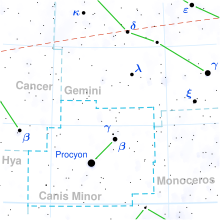
| |
| Observation data Epoch J2000.0 Equinox J2000.0 (ICRS) | |
|---|---|
| Constellation | Canis Minor |
| Right ascension | 07 51 41.98835 |
| Declination | +01° 46′ 00.7395″ |
| Apparent magnitude (V) | 5.13 |
| Characteristics | |
| Spectral type | B8 II |
| U−B color index | −0.46 |
| B−V color index | −0.13 |
| Astrometry | |
| Radial velocity (Rv) | +32.3±2.8 km/s |
| Proper motion (μ) | RA: −14.43 mas/yr Dec.: −2.40 mas/yr |
| Parallax (π) | 5.23 ± 0.36 mas |
| Distance | 620 ± 40 ly (190 ± 10 pc) |
| Absolute magnitude (MV) | −1.32 |
| Details | |
| Mass | 3.98±0.10 M☉ |
| Luminosity | 490 L☉ |
| Surface gravity (log g) | 3.36 cgs |
| Temperature | 13,500 K |
| Rotational velocity (v sin i) | 28.0 km/s |
| Other designations | |
| ζ CMi, 13 CMi, BD+02° 1808, GC 6, HD 63975, HIP 38373, HR 3059, SAO 116043 | |
| Database references | |
| SIMBAD | data |
Zeta Canis Minoris (ζ Canis Minoris) is a solitary, blue-white hued star in the equatorial constellation of Canis Minor. It is a dim star but visible to the naked eye with an apparent visual magnitude of 5.13. Based on an annual parallax shift of 5.23 mas as seen from Earth, this star is located around 410 light years from the Sun. It is moving away from the Sun with a radial velocity of +32.3 km/s.
This is a B-type bright giant star with a stellar classification of B8 II. It is a Mercury-Manganese star, showing an overabundance of these elements in its spectrum. The mean longitudinal magnetic field strength is 8.28±11.55 G. The star has about four times the mass of the Sun and is radiating 490 times the Sun's luminosity from its photosphere at an effective temperature of 13,500 K.
References
- ^ van Leeuwen, F. (2007), "Validation of the new Hipparcos reduction", Astronomy and Astrophysics, 474 (2): 653–664, arXiv:0708.1752, Bibcode:2007A&A...474..653V, doi:10.1051/0004-6361:20078357, S2CID 18759600.
- ^ Fernie, J. D. (May 1983), "New UBVRI photometry for 900 supergiants", Astrophysical Journal Supplement Series, 52: 7–22, Bibcode:1983ApJS...52....7F, doi:10.1086/190856.
- ^ Houk, N.; Swift, C. (1999), "Michigan catalogue of two-dimensional spectral types for the HD Stars", Michigan Spectral Survey, 5, Department of Astronomy, Univ. Michigan, Bibcode:1999MSS...C05....0H.
- ^ de Bruijne, J. H. J.; Eilers, A.-C. (October 2012), "Radial velocities for the HIPPARCOS-Gaia Hundred-Thousand-Proper-Motion project", Astronomy & Astrophysics, 546: 14, arXiv:1208.3048, Bibcode:2012A&A...546A..61D, doi:10.1051/0004-6361/201219219, S2CID 59451347, A61.
- Huang, W.; et al. (2012), "A catalogue of Paschen-line profiles in standard stars", Astronomy & Astrophysics, 547: A62, arXiv:1210.7893, Bibcode:2012A&A...547A..62H, doi:10.1051/0004-6361/201219804, S2CID 119286159.
- ^ Hohle, M. M.; et al. (April 2010), "Masses and luminosities of O- and B-type stars and red supergiants", Astronomische Nachrichten, 331 (4): 349, arXiv:1003.2335, Bibcode:2010AN....331..349H, doi:10.1002/asna.200911355, S2CID 111387483.
- ^ Ghazaryan, S.; Alecian, G. (August 2016), "Statistical analysis from recent abundance determinations in HgMn stars", Monthly Notices of the Royal Astronomical Society, 460 (2): 1912–1922, Bibcode:2016MNRAS.460.1912G, doi:10.1093/mnras/stw911
- "zet CMi". SIMBAD. Centre de données astronomiques de Strasbourg. Retrieved 2017-08-31.
- Eggleton, P. P.; Tokovinin, A. A. (September 2008), "A catalogue of multiplicity among bright stellar systems", Monthly Notices of the Royal Astronomical Society, 389 (2): 869–879, arXiv:0806.2878, Bibcode:2008MNRAS.389..869E, doi:10.1111/j.1365-2966.2008.13596.x, S2CID 14878976.
- Makaganiuk, V.; et al. (January 2011), "The search for magnetic fields in mercury-manganese stars", Astronomy and Astrophysics, 525: A97, arXiv:1010.3931, Bibcode:2011A&A...525A..97M, doi:10.1051/0004-6361/201015666, S2CID 118860674.
| Constellation of Canis Minor | |||||||||||
|---|---|---|---|---|---|---|---|---|---|---|---|
| Stars |
| ||||||||||
| |||||||||||
| Galaxies |
| ||||||||||